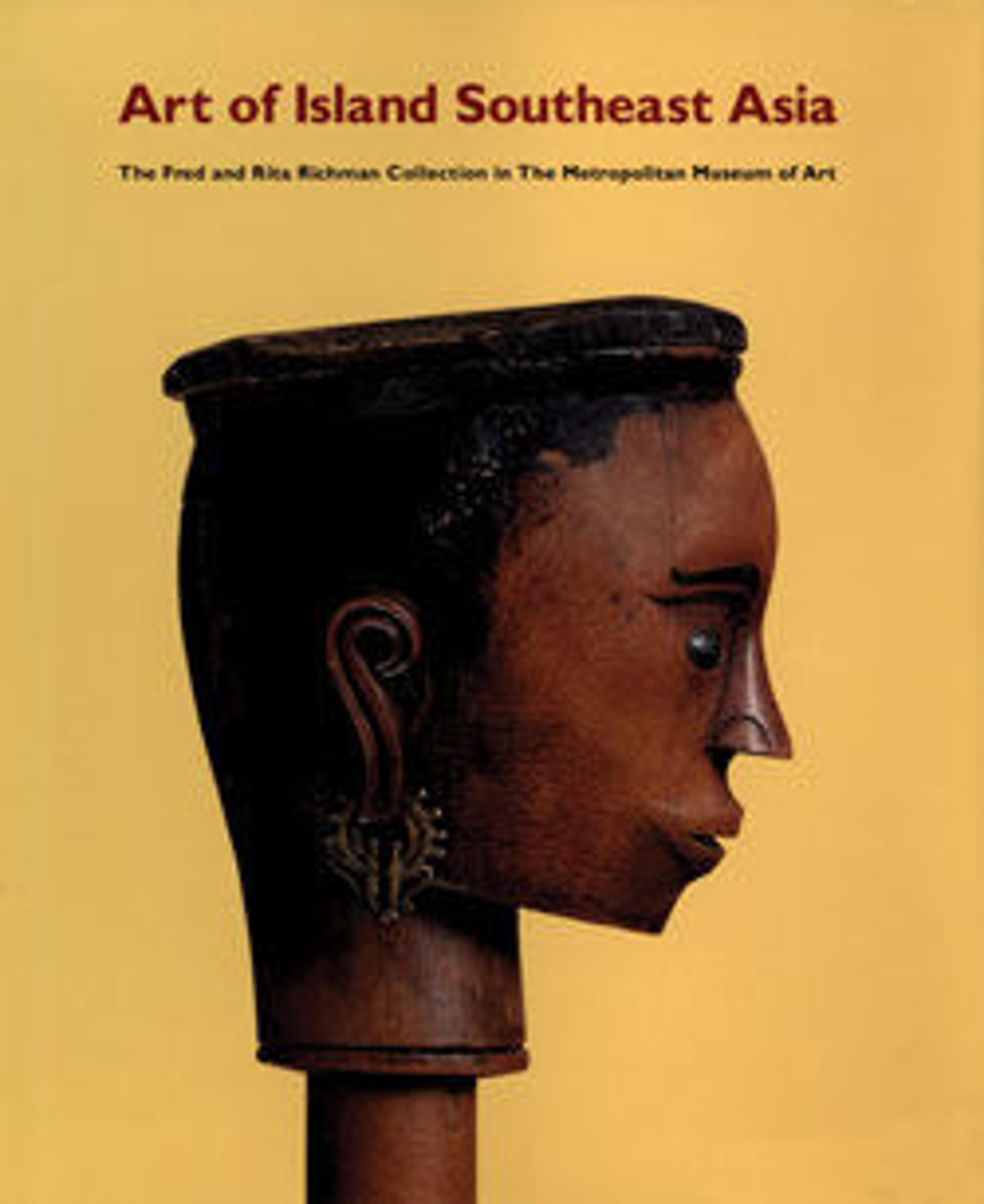Perminangken (container for magical substances)
The carved wooden stopper of this container depicts a human figure mounted on a horse with the exaggerated head of a singa, a mythical creature that figures prominently in Toba Batak art. With distinct nose, mouth, eyes, and strongly protruding chin, the mount’s human-like face is as big as the rider seated above. The stopper fits into a translucent green jar manufactured in China, probably in the thirteenth or fourteenth century, during the Yuan dynasty. The use of imported Chinese ceramics by the Batak and other Indonesian groups reflects the highly developed trade network that flourished in the region centuries before the arrival of Europeans. The wooden stopper on this vessel was carved locally by a Toba Batak artist, and the container was used to hold pukpuk, a powerful substance made from ritually prepared human and animal remains. To enliven sacred objects such as ritual staffs and human figures, pukpuk was applied to the surface or inserted into holes in the object that were later plugged, sealing the power within.
The Toba Batak, one of six groups among the Batak peoples of northern Sumatra, live in the mountainous highlands surrounding Lake Toba (the birthplace of the Batak, according to oral histories and myths). The Batak maintained trade relations with their Malay neighbors living on the coast but otherwise remained relatively isolated until the 18th and 19th centuries when Dutch and British traders, along with German missionaries, established operations in Sumatra. Although nearly all Batak today are Christian or Muslim, they formerly recognized diverse supernatural beings, including deities, ancestors, and malevolent spirits. The primary religious figures in Batak society were male ritual specialists, called datu by the Toba Batak, who acted as intermediaries between the human and spiritual worlds. Much of Toba Batak sacred art centered on the creation and adornment of objects that would be used by the datu for divination, curing ceremonies, malevolent magic, and other rituals. Among the most important were ceremonial staffs, books of ritual knowledge, and a variety of containers used to hold magical substances, such as this perminangken.
References
Capistrano-Baker, Florina H. Art of Island Southeast Asia. The Fred and Rita Richman Collection in The Metropolitan Museum of Art. New York: The Metropolitan Museum of Art, 1994, pp. 50, fig. 22
Sibeth, Achim. The Batak. London: Thames and Hudson, 1991
The Toba Batak, one of six groups among the Batak peoples of northern Sumatra, live in the mountainous highlands surrounding Lake Toba (the birthplace of the Batak, according to oral histories and myths). The Batak maintained trade relations with their Malay neighbors living on the coast but otherwise remained relatively isolated until the 18th and 19th centuries when Dutch and British traders, along with German missionaries, established operations in Sumatra. Although nearly all Batak today are Christian or Muslim, they formerly recognized diverse supernatural beings, including deities, ancestors, and malevolent spirits. The primary religious figures in Batak society were male ritual specialists, called datu by the Toba Batak, who acted as intermediaries between the human and spiritual worlds. Much of Toba Batak sacred art centered on the creation and adornment of objects that would be used by the datu for divination, curing ceremonies, malevolent magic, and other rituals. Among the most important were ceremonial staffs, books of ritual knowledge, and a variety of containers used to hold magical substances, such as this perminangken.
References
Capistrano-Baker, Florina H. Art of Island Southeast Asia. The Fred and Rita Richman Collection in The Metropolitan Museum of Art. New York: The Metropolitan Museum of Art, 1994, pp. 50, fig. 22
Sibeth, Achim. The Batak. London: Thames and Hudson, 1991
Artwork Details
- Title:Perminangken (container for magical substances)
- Artist:Toba Batak artist
- Date:19th–early 20th century
- Geography:Indonesia, Sumatra
- Culture:Toba Batak
- Medium:Wood, ceramic
- Dimensions:H. 6 5/8 × Diam. 2 1/2 in. (16.8 × 6.4 cm)
- Classification:Ceramics-Containers
- Credit Line:Gift of Fred and Rita Richman, 1988
- Object Number:1988.143.40
- Curatorial Department: The Michael C. Rockefeller Wing
More Artwork
Research Resources
The Met provides unparalleled resources for research and welcomes an international community of students and scholars. The Met's Open Access API is where creators and researchers can connect to the The Met collection. Open Access data and public domain images are available for unrestricted commercial and noncommercial use without permission or fee.
To request images under copyright and other restrictions, please use this Image Request form.
Feedback
We continue to research and examine historical and cultural context for objects in The Met collection. If you have comments or questions about this object record, please contact us using the form below. The Museum looks forward to receiving your comments.
